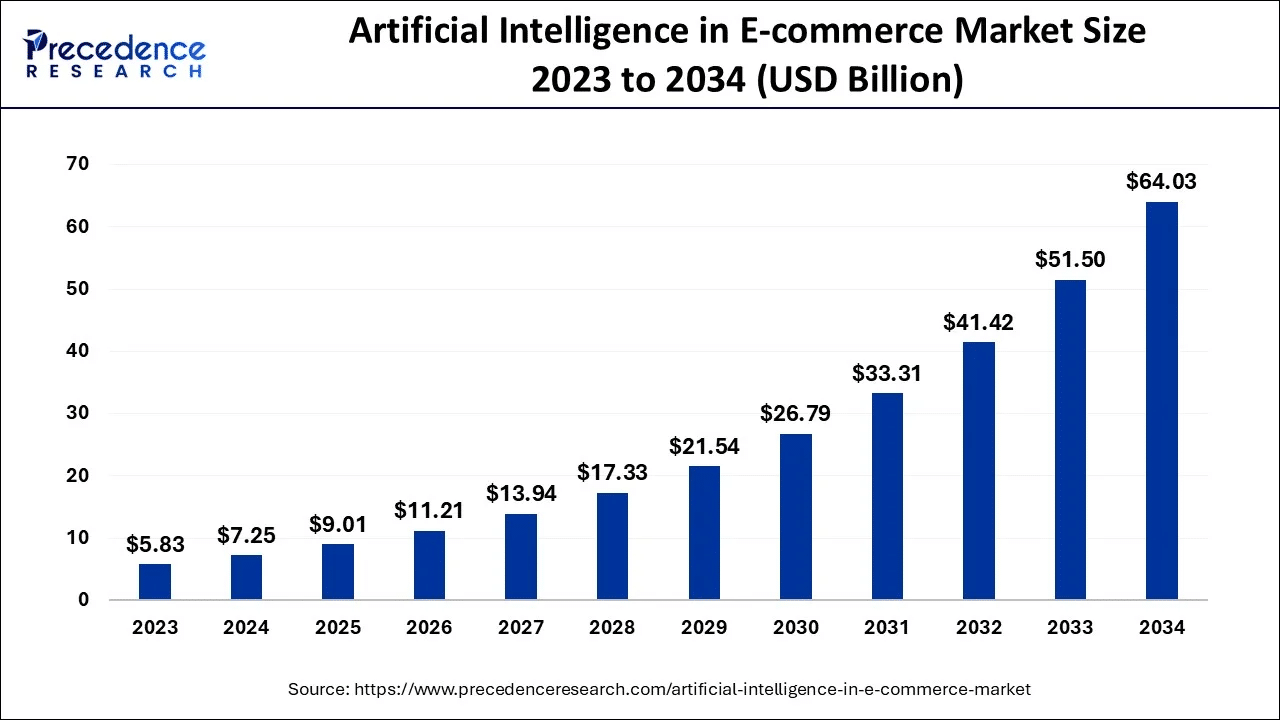A recent industry survey by Deloitte found that 44% of retail executives want to enhance omnichannel experiences in 2025. Omnichannel retail has evolved rapidly over the past few years and is expected to grow even more.
But why is there so much growth, and why does it matter? The main reason is simple: This rapid growth reflects the increasing demand for convenient and personalized shopping experiences that blur the lines between online and offline channels.
Keeping pace means embracing advanced technologies like AI and offering hyper-personalized interactions.
Whether you’re a retailer looking to stay ahead of the curve or a consumer curious about the future, this guide will help you understand the dynamic world of 2025 omnichannel retail.
How Will AI Drive Hyper-Personalization in 2025?
The e-commerce market’s use of AI was valued at $7.25 billion in 2024, climbed to $9.01 billion in 2025, and is set to soar past $64.03 billion by 2034. This trend reflects a strong CAGR of 24.34% from 2024 to 2034, highlighting how rapidly this market is evolving.

AI is already fueling customer engagement trends across multiple touchpoints—from personalized product recommendations to targeted marketing offers.
AI in eCommerce is projected to become even more sophisticated, predicting customer intent more accurately and adapting to real-time behavior changes.
This evolution is a natural extension of data-driven personalization that many retailers already practice, but on a significantly deeper scale. After all, studies have demonstrated how adding extensive personalization that can, for example, offer predictive offerings increased average revenue per user by 166%.
The impact on loyalty and conversions
Hyper-personalization doesn’t just boost sales; it also fosters customer loyalty personalization. When shoppers feel recognized and valued, they’re more likely to return and spend more over time.
With next-level machine learning, brands can anticipate individual buying patterns, tailor promotions to personal tastes, and reduce the time it takes to purchase. This increases brand loyalty—31% of customers are more likely to remain loyal due to personalizing shopping experiences.
A dynamic AI system can continually refine its approach, suggesting relevant products and offering timely incentives. As a result, retailers see higher conversion rates, stronger brand advocacy, and healthier profit margins.
Enhancing personalized marketing with AI
Through personalization solutions like SAP Emarsys, AI algorithms analyze extensive datasets—such as browsing behavior, purchase history, and real-time engagement.
By leveraging AI models that learn and adapt over time, brands can drive personalization at scale and transform one-off promotions into evolving, context-aware marketing journeys.
What Role Will Integrated Voice and Visual Search Play in Omnichannel Strategies?
Search functionality is often a customer’s first real interaction with a brand—be it through a voice assistant at home or a camera-based visual search on a mobile app. As we approach 2025, integrated search technologies are becoming more intuitive, adding a new layer to omnichannel personalization.
Voice search: A conversational gateway
The widespread adoption of smart speakers and mobile voice assistants drives voice search growth. For retailers, this means optimizing product listings and marketing content for spoken queries —prioritizing conversational keywords and structured data that voice algorithms can interpret accurately.
Voice-enabled shopping experiences also offer hands-free convenience, letting customers re-order favorites or discover new items without ever touching a screen.
Visual search: Turning images into opportunities
Visual search empowers shoppers to upload or capture images and instantly find similar products. Advanced image recognition helps retailers surface relevant items, bridging the gap between in-store inspiration and online browsing.
Suppose a customer spots a pair of shoes on social media; with a visual search, they can quickly locate the product or a similar style in the retailer’s catalog.
Integrating visual search with AI-driven personalization further refines the results, tailoring recommendations to the customer’s style preferences and size.
Building trust through user-friendly search
As these technologies evolve, retailers must ensure a seamless search experience across all channels. Linking voice and visual search data with customers’ browsing history and loyalty profiles facilitates frictionless discovery.
Learn more about personalization to see how automated, AI-enhanced systems can unify these touchpoints and deliver consistent, personalized experiences that boost user satisfaction.
What Does Seamless Cross-Channel Experience Mean for Retailers?
The lines between online and offline shopping are erased in a modern omnichannel world. Customers hop from a store’s mobile app to its physical location, then browse a social platform, expecting consistent interactions at every turn.
To meet these expectations, retailers must unify inventory management, payment systems, marketing campaigns, and loyalty programs into one coherent experience by 2025. Let’s learn more about these.
- Synchronized data and inventory: When customers browse your website and then visit your fiscal store, they shouldn’t have to start from scratch. A seamless cross-channel approach ensures real-time visibility of stock levels, customer data, and order history across all touchpoints.
- Blending online and offline: Digital signage, app-based coupons, and contactless payments are just a few ways to combine online conveniences into physical retail. Likewise, immersive technologies like augmented reality (AR) can bring the feeling of trying on clothes or testing out products to customers at home.
- Overcoming omnichannel challenges: Transitioning to a fully connected retail model has hurdles. Data silos, legacy systems, and disconnected marketing channels can slow progress. However, a unified approach can help retailers address common omnichannel marketing challenges.
By aligning teams, workflows, and technology under a single strategy, you can create experiences that delight customers and keep them returning for more.
How Will Advanced Analytics and Data Utilization Shape Retail Strategies?
With an ever-growing volume of consumer data, retail success hinges on extracting meaningful insights. Advanced analytics and predictive modeling equip businesses to understand buyer behavior, forecast demand, and improve operational efficiency.
Here are some tips for going beyond surface metrics and tips for data platforms and actionable insights:
- Deepen your KPIs: Look beyond basic clicks and conversions. Track metrics like customer lifetime value, churn propensity, and cohort behavior.
- Identify high-value segments: Instead of focusing solely on broad audiences, prioritize resources toward shoppers who yield the most significant long-term return.
- Refine pricing and product design: Use detailed analytics to inform strategic decisions around price adjustments, assortment planning, and more.
- Aggregate cross-channel data: Combine information from web, mobile, in-store, and social channels into a single platform to gain a holistic view of customer interactions.
- Leverage AI tools: Spot patterns and recommend immediate actions (e.g., offering free shipping if customers frequently abandon carts due to delivery fees). SAP Emarsys AI-powered analytics provides you with insightful, revenue-driving marketing and more.
- Adapt in real-time: Monitor analytics continuously to fine-tune campaigns and promotions for maximum engagement.
What Enhancements Are Needed for Mobile Shopping Experiences?
Mobile commerce shows no signs of slowing down. The mobile ecommerce market is projected to reach $1.54 trillion in 2025 and $2.12 trillion by 2030, with a CAGR of 6.54% throughout the forecast period (2025-2030).
Faster load times and seamless checkout
Mobile shoppers are often “on the go,” so site speed and user-friendly checkout processes can make or break a sale. Swift load times, intuitive navigation, and one-click payment options keep friction to a minimum. Streamlined UX is especially critical when capturing impulse buys or quick reorders.
Setting up your mobile wallet is significant in engaging mobile customers anywhere. Learn how SAP Emarsys Mobile Wallet solution can help launch personalized campaigns with mobile wallet passes such as digital vouchers, coupons, tickets, and loyalty cards.
Tailored features for on-the-go consumers
Location-based offers, push notifications for limited-time deals, and user-friendly app interfaces encourage spontaneous shopping.
For instance, a retailer might send a geotargeted coupon when a customer is near a physical store or display relevant local inventory. These strategies drive sales and enhance the overall ecommerce customer experience by providing timely value.
Learn how SAP Emarsys facilitates real-time mobile customer engagement, leveraging customer, product, and sales data from various channels.
Supporting offline-online journeys
Many customers begin their searches on mobile but prefer finalizing purchases in person, or vice versa. Retailers can deliver the best of both worlds by unifying mobile and offline data.
The mobile app might list local store hours and stock levels or offer easy ways to schedule in-store pickups. By taking an integrated approach, you’ll be ready to maximize omnichannel results and satisfy a broader range of shopping preferences.
How Can Retailers Stay Ahead in the Omnichannel Retail World of 2025?
With evolving technologies, rising consumer expectations, and a growing emphasis on sustainability, staying ahead in omnichannel retail requires proactive adaptation. Here are the key strategies for retailers looking to thrive in 2025 and beyond.
1. Embrace continuous innovation
Technologies like AR, VR, and AI will continue to reshape customer engagement trends. Retailers regularly exploring new tools—such as advanced personalization or immersive shopping experiences—will be better positioned to adapt quickly. Evaluate, test, and iterate to discover which innovations resonate most with your audience.
2. Centralize your data and systems
A single source of truth for customer and inventory data removes silos, streamlines marketing efforts, and enables consistent, personalized messaging across all channels. Leveraging platforms such as SAP Emarsys helps consolidate data and deliver omnichannel for ecommerce retailers, ensuring your campaigns remain agile and relevant.
3. Build a culture of customer-centricity
Encourage every department—from sales to customer service—to prioritize the ecommerce customer experience. Continuous feedback loops, user surveys, and data analysis can uncover hidden pain points, guiding you to refine both your digital and in-store strategies. This mindset fosters lasting loyalty and word-of-mouth referrals.
4. Partner for success
Omnichannel retail demands a broad skill set—covering logistics, data analytics, technology integration, and more. Collaborating with reputable technology providers like SAP Emarsys can help retailers gain an edge. Our platform provides the infrastructure, personalization at scale, and strategic insights you need to adapt to shifting market conditions.
Ready to Take the Next Step?
As ecommerce personalization trends continue to dominate the retail conversation, having the right strategy and tools in place is crucial.
If you want to harness AI, boost customer loyalty, and create a seamless experience across every channel, SAP Emarsys can help.
Book a personalized demo today and see how our comprehensive solutions can transform your brand’s omnichannel performance.
By embracing a forward-looking approach and prioritizing innovation, you’ll not only meet rising consumer demands—you’ll stay a step ahead in the competitive world of 2025 and beyond.








